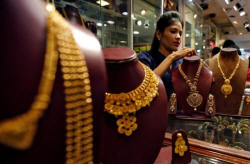In India, digital gold sellers hope trickle will become
a rush
 Send a link to a friend
Send a link to a friend
 [March 21, 2018]
By Arpan Varghese [March 21, 2018]
By Arpan Varghese
(Reuters) - A digital revolution is
reshaping India's $34 billion gold market, with smartphones, e-wallets
and flexible investment schemes drawing new buyers into a business
dominated by traditional, face-to-face transactions.
Digital payment systems have ballooned in popularity in India since the
government scrapped large-value bank notes in 2016.
Among these offerings are applications that enable smartphone users to
buy, sell or store gold - even in small amounts - kept in secured vaults
operated by MMTC-PAMP India Pvt Ltd, a joint venture between MMTC Ltd,
the largest national trading firm, and Swiss gold refiner PAMP.
Although online gold purchases have been growing globally for years,
they are a relatively recent phenomenon in India, where jewelry and bars
of the precious metal tend to be kept in hand and given as gifts.

"In India, the action is really starting now. The digitization of the
economy will certainly lead to digitization of gold," said Somasundaram
PR, managing director of World Gold Council's (WGC) India operations.
"It is poised for significant growth, possibly in the next 12-24
months."
(For a graphic on India's gold market click http://tmsnrt.rs/2b1Tl6J)
The WGC estimated total Indian gold demand at 727 tonnes (25.6 million
ounces) in 2017, and could be up to 800 tonnes in 2018. In China, the
top consumer, 2017 demand was 953.3 tonnes.
It is difficult to gauge how many new buyers are entering the market
because of online access. The digital payments firm Paytm said that in
the first six months after it began offering digital gold last April, it
facilitated about $18.4 million worth of sales - a tiny fraction of the
Indian gold market.
With the vast majority of purchases made in the traditional way, demand
for physical gold isn't abating, "especially when physical gold plays an
important role at Indian weddings," said Naeem Aslam, chief market
analyst at Think Markets UK Ltd.
(For a graphic on physical gold demand in India, China and the world
click http://reut.rs/2G7Bav2)
NEWLY ATTRACTIVE
Besides convenience, Indian consumers are attracted to competitive
pricing and ability to make purchases in tiny increments.
Gold-based financial offerings, including Gold Accumulation Plans (GAPs),
allow users to buy and store gold in fractions as small as 0.1 grams -
an amount that would be an uneconomical to trade physically because of
the associated handling costs.
These accumulation plans, along with gold-backed bonds and websites
selling coins and jewelry that can be shipped for free or cheaply within
India, are especially appealing to young Indians. In the past, even
those with an enduring affinity for gold have needed to wait until they
have saved enough to build holdings.

Joe Jacob, a 29-year-old entrepreneur in the southern city of Bengaluru,
recently bought 5 rupees (8 cents) worth of digital gold as a "trial
investment."
"Physical gold is a hassle in terms of storage, and I don't wear gold,
but understand it is an asset to hold. Digital gold is better than
storing the actual metal at home, worrying about its safety," he said.
[to top of second column] |

A salesperson attends to a customer (not pictured) inside a
jewellery showroom, during Akshaya Tritiya, a major gold-buying
festival, in Mumbai, India April 28, 2017. REUTERS/Shailesh
Andrade/File photo

Security experts said that because the gold, guaranteed to physically exist in
an MMTC PAMP vault, was insured, there was little risk of fraudulent sales.
And digital wallet providers expect interest to grow.
Paytm leads the crowded e-wallet space in India and announced two new gold gift
and savings plans this month after launching its first digital gold product in
April 2017. The company, backed by Japan's SoftBank Group and China's Alibaba,
sources its 24-carat gold from MMTC PAMP.
"There is no 'season' for this product; it is running twenty-four seven. Sitting
in their offices, homes or wherever they want, they can easily access, buy sell
or redeem," said Gaurav Singh, deputy general manager of marketing at MMTC PAMP.
Gold trading traditionally peaks around festival and wedding seasons, experts
say.
But Singh added that because digital gold lowers the minimum price needed to buy
gold - from about 3,000 rupees previously, enough to buy roughly 1 gram of gold
at current prices - and boosts market transparency via live pricing, there has
been a rise in the frequency of gold purchases at other times of the year.
Nitin Misra, senior vice president at Paytm confirmed a similar trend, noting
"about 40 percent of sales" happen during the "off-season" for buying gold in
India.
He said more than half of the company's users were repeat customers, and 70
percent were younger than 35. As of December 2017, about 1.4 million of its
customers held some gold balance in their e-accounts.
"We have stumbled upon a brand new segment," he said of younger users buying
gold. "What we have done, is not cannibalize the existing market, but grown it."

The company said last year it planned to sell $200 million worth of gold in the
2017 fiscal year, which ended March 1. But its reported sales in 2017 appeared
to be headed far short of that number.
Its rival e-wallet provider PhonePe was upbeat.
"The gold consumption market is expected to grow by 35 percent from 2015 to
2020, and customers are exploring digital options for purchase," it said in an
emailed statement.
For Bangalore-based P Vinoth, a logistics consultant who still prefers buying
ornaments and jewelry from retail stores, e-wallets now offer an alternative.
"For long term, I previously invested in exchange-traded funds. Now I am using
Paytm gold," he said.
($1 = 64.9800 Indian rupees)
(Additional reporting by N R Sethuraman in Bengaluru; Editing by Gavin Maguire
and Gerry Doyle)
[© 2018 Thomson Reuters. All rights
reserved.] Copyright 2018 Reuters. All rights reserved. This material may not be published,
broadcast, rewritten or redistributed.
Thompson Reuters is solely responsible for this content. |